|
 
IN
THE NEWS | GARDEN | PUBLISHER | CALENDAR
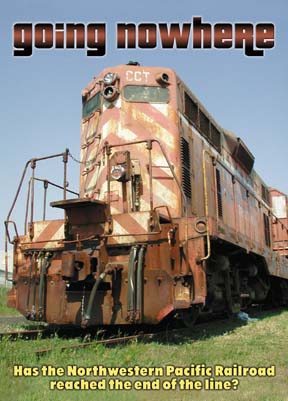
by HANK SIMS
HUMBOLDT COUNTY IS KNOWN FOR
ITS BRASH FOREST DEFENDERS, its Green Party politics and its
quaint, tourist-friendly towns. Of course, it wasn't always so.
The county was once a solid blue-collar area with a vast natural
resource base. For the last few years, as Humboldt residents
know all too well, an economic crisis has been deepening. Timber
production has dwindled, and the fishing industry has all but
vanished. Nowadays the county's principal export is probably
its high-grade marijuana crop.
As in any provincial community
left behind by post-industrial America, local elected officials
and business leaders dream of finding their way into the new
economy. Many in Humboldt pin their hopes on the Northwestern
Pacific Railroad, a dormant old spur of the Southern Pacific
currently run by the North Coast Railroad Authority, a state
agency. If the port of Humboldt Bay could be connected into the
national rail system, the thinking goes, it could attract cargo
ships from all over the Pacific Rim. All that's lacking is the
trains.
There are about 550 short-line
railroads in the United States, the majority of them, like the
Northwestern Pacific, running on tracks abandoned by the Union
Pacific, the Southern Pacific, the Santa Fe, or one of the other
behemoths that dominated transportation in the early part of
the last century. It is like other short-lines in many ways;
it seeks to wring a profit from an industry that seems to belong
to a different era. But in at least a couple of ways, the Northwestern
Pacific couldn't be more different. For one, it is operated
by a government agency, one created by the California State Legislature
in 1989 and ultimately owned by the public. Public funds have
been poured into the NCRA over the last 10 years, with little
to show for the effort. Also, the Northwestern Pacific line is
ill-sited and disaster-ridden -- its critics have called it the
most expensive line in the country to maintain.
Eleven years ago, in the midst
of a recession, California bought the deeply troubled rail line
with the intention of trying to boost the struggling economy
of the state's rural north. But today, the story is of a colossal
planning disaster that could force taxpayers to cough up hundreds
of millions of dollars just to get the public out of the train
business. It could cost them even more to keep it going.
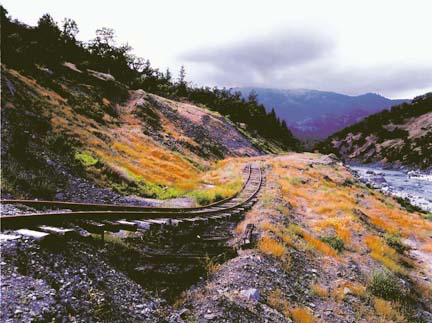
Neglected tracks in the
Eel River Canyon [photo by John Mahony]
A
crumbly canyon
The biggest of the railroad's
many problems is a remote stretch of the line that hugs the bank
of the Eel River and connects Humboldt County with points south.
The walls of the Eel River Canyon are constituted mostly of shale
and clay, feeble materials that disintegrate when winter storms
batter the region. Time after time in the railroad's 85-year
history (the track was opened in 1914), rains have washed cars,
engines and track into the river. Service has been down for more
than four years, thanks to a stop-work order by the Federal Railroad
Administration. Much of the track lies in ruin. Federal authorities
say it will take $650 million to make the track work over the
long term and even the NCRA concedes there's $300 million in
construction needs over the next 25 years.
Over $110 million in state,
federal and local taxpayer money has been awarded to revive the
NWP: $43 million to buy the line, $12 million for disaster relief,
and, most recently, $60 million in "traffic congestion relief"
funds from Gov. Gray Davis' 2000-01 budget. Of the $60 million
grant from Davis, earmarked for ground stabilization and repayment
of the NCRA's debts to subcontractors, only $19 million has been
doled out by the California Department of Transportation in small
disbursements, with some $41 million still outstanding.
Now, with the state suffering
the greatest budget deficit in its history, that $41 million
allocation has been frozen indefinitely. The railroad is not
being singled out -- all projects in the state that had not already
signed contracts that would be paid by the fund have likewise
seen their traffic congestion relief money disappear. The NCRA
hopes that its $41 million will eventually be unlocked, sometime
in the future when the state is flush again. But if and when
that happy day arrives, there is reason to fear that the railroad
will be at the bottom of the state's priorities. There's no question
that since its creation the authority has caused the state many
more problems than it has solved.
The suspension of state funds
has caused the authority to retool, at least for now. In the
past, the NCRA had always insisted that the railroad would only
be viable if its whole length, from Marin County to Humboldt
Bay, were reopened. After all, the bulk of the goods carried
on the line -- lumber and products brought in by ships stopping
at Humboldt Bay -- would be loaded onto the southbound train
in Eureka.
Now, though, the only practical
way to get trains running again is to focus on the south end
of the line, from Marin to Willits. The NCRA believes that money
owed to it by the Federal Emergency Management Agency and the
state Office of Emergency Services would be enough to repair
that stretch of track. Doug Christy, the authority's outgoing
executive director, told the board last week that trains could
be up and running in 12 months -- though, as he was reminded
by board member Allan Hemphill, the authority has a "sordid
history" when it comes to meeting its reopening projections
(Christy announced his departure earlier this month; he is taking
a job with a trucking concern in the Midwest).
The new plan, if successful,
wouldn't restore rail service to Humboldt County. But it would
at least demonstrate that the NCRA could run a railroad after
so many unproductive years. A working railroad on the south end,
it is hoped, would lend credibility to efforts to reopen the
north.
But that means leaving the storm-wracked
Eel River Canyon section of the line to suffer through an unknown
number of winters, with additional major damage to the track
a certainty. That is, unless the gravel industry -- which reportedly
has become very interested in the canyon -- comes to the rescue.
There has been talk of a deal to open up the canyon to mining
in exchange for track restoration work in the southern half of
the canyon. But so far it's just talk.
Bad
omen
The "golden spike"
that officially opened the Northwestern Pacific Railroad was
driven in the summer of 1914 at Cain Rock, deep into the wilds
of the Eel River Canyon. The new railroad was of no small consequence;
with the coming of the line, the vast natural resources of the
northern part of the state would finally find a ready route to
San Francisco markets. At the opening, two trains -- one from
Eureka, one from San Francisco -- would meet in the canyon, where
dignitaries would perform the ceremony and then proceed to Eureka
for a three-day festival. Future California governor James "Sunny
Jim" Rolph, then San Francisco's mayor, would lead the Bay
Area delegation.
But on the day the spike was
pounded home, word reached the party that the tracks north of
Cain Rock had slid out, leaving the dignitaries stranded until
the wee hours of the next morning. Salmon were fished out of
the river and barbecued, and the archival footage that survives
the event shows that the several-hour delay did no damage to
Rolph's legendary good cheer.
It was a portentous beginning
for a railroad that would suffer such calamities throughout its
history. In January 1953, the Eureka Times-Standard ran
a gruesome photograph taken at the northern end of the Eel River
Canyon, with this caption:
"The towering mountainsides
which rise above many sections of the Northwestern Pacific Railroad
tried three times last week to send the trains hurtling into
the river canyons below. Twice they knocked them from the tracks
to the brink of destruction. The third time they succeeded, as
tons of rock, earth and debris slipped suddenly from the face
of Scotia Bluffs and sent three men to their death in the swirling,
flood-swollen Eel, trapped in the cab of an 80-ton locomotive."
In total, 11 railroad workers
have been killed by the slip-outs and slides that plague this
section of the track, with untold damages to property.
The problem is location. To
get from the Bay Area to Humboldt County, one must somehow traverse
the choppy mountains known collectively as the Coast Range. Geologists
refer to this area as the Franciscan complex, a landmass born
of the union of the Farallon and Pacific tectonic plates. The
Franciscan complex is a geological infant; its rivers and mountains
have far to go before they stabilize. The area is one of the
most seismically active in the world.
Faced with a scarcity of relatively
level ground, founders of the Northwestern Pacific chose to place
most of their railroad alongside rivers. From Cloverdale to Willits,
in Mendocino County, the line runs next to the Russian River.
From Willits to Scotia, in Humboldt County, it runs next to the
middle fork of the Eel River -- sometimes less than 100 feet
above the river itself. Even barring severe floods, damage to
the track in a normal winter is extensive. Now, with the line
fallow for years, much of the track is in complete ruin.
Despite these headaches, the
Southern Pacific was able to make a go of the line until the
early 1980s. For years, the massive North Coast redwood industry
provided the rail giant with a steady source of revenue. But
in 1983, the SP filed a petition with the Interstate Commerce
Commission asking for permission to abandon the line. Freight
revenues had dropped, the company claimed, and maintenance costs
had increased -- to the point where it was losing nearly $1 million
a month on the line. The California Public Utilities Commission
challenged the SP's petition, charging that the railroad was
a vital component of the North Coast economy. The ICC concurred,
ordering the SP to continue operations on the line.
In 1984, though, the company
was able to unload the northern half of the NWP, including the
Eel River Canyon, to one of its former managers. The new operation,
called the Eureka Southern, ran trains for two years before declaring
bankruptcy. The Eureka Southern limped along under a court-appointed
trustee until 1992, when the newly created NCRA purchased it
for $5.2 million. (The portion of the track closest to the Bay
Area, more expensive due to higher land values, would be acquired
later.)
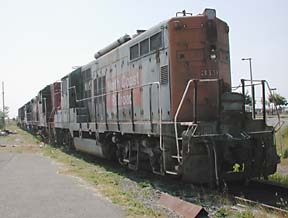 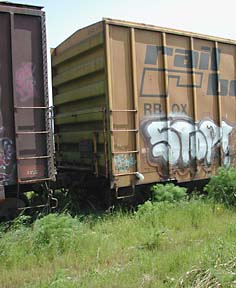
Left: Engines parked at Eureka's
Old Town. Right: Abandoned boxcar parked in Eureka Balloon Track.
[photos by Bob Doran]
A
last-ditch attempt
Former state assemblyman and
current Arcata City Manager Dan Hauser wrote the legislation
that engineered the state buyout of the NWP. Today, Hauser said
that he and Barry Keene, who represented the region in the state
Senate at the time, were both committed to seeing the railroad
continue, and that the NCRA was a last-ditch attempt to save
it. "The handwriting was on the wall," he said. "Old-growth
redwood was going to become a thing of the past. We were looking
for ways to expand the economic base. The railroad was critical
to this effort, and we had to give [the NCRA] a try."
Given the modest initial investment,
Hauser said, it wasn't difficult to persuade the Legislature
to pass their bill. "It was one of those types of issues
that affected our district without detracting from their districts,
and you tend as a legislator to support your colleagues in that
kind of effort," he said. "Barry Keene was majority
leader of the Senate, so he didn't have to [twist many arms],
and I had developed a fairly good reputation in the Assembly."
However, the NCRA's mandate
began to expand soon afterwards. The authority acquired another
portion of the old NWP track, down to Healdsburg, and the sole
rights to run freight on the rest of the track (as well as the
responsibility of maintaining it). After trying and failing to
run its own trains, it eventually entered into a long-term contract
with a private operator. The authority would focus on maintaining
the tracks -- a task at which it also fell short. In November
1998, the Federal Railroad Authority, citing extensive unsafe
conditions on the line, issued an emergency order halting all
activity on the line until it could be brought up to minimal
safety standards. Apart from a few runs on the southernmost end
of the line in 2001, no trains have passed down NWP tracks since.
Throughout 2002, the NCRA ran
on fumes. The authority received some of the $60 million in traffic
congestion relief funds that the governor promised it in 1998,
but much of that was used to pay debts and to fund studies on
the cost of fixing the line and the railroad's long-term financial
viability. Day-to-day administration costs were recouped through
the lease of NCRA property -- mainly from several miles of fiber
optic lines along the NCRA's right-of-way. Last January, when
the NCRA board met to fine-tune a presentation to the California
Transportation Commission later that month, there was a strong
fear that the authority was nearing collapse. Several members
of the NCRA board endorsed the view that the CTC should be told
that it was "time to fish or cut bait."
"This thing is out of gas,"
NCRA Director Allan Hemphill said at the meeting. He advocated
a tough line with the state. "I'm not going to waste another
nine years screwing around with this thing unless we can get
them to move."
Rays
of hope
But amid this backdrop of desperation,
NCRA officials found a couple of rays of hope -- the line may
not be as costly to fix as they previously imagined, and they
might have found a private company to invest in the line.
Until last summer, the only
hard estimate of how much long-term repairs to the Eel River
Canyon might cost came from FEMA and the state Office of Emergency
Services. In the mid-'90s, FEMA and the OES began to wonder whether
the money it had spent on the Northwestern Pacific over the years
addressed true catastrophic events, or whether storm-related
damage was simply a cost of doing business in the canyon. The
two agencies commissioned a study that concluded that unless
some $650 million were invested in stabilizing the canyon walls,
the railroad could be expected to bear extensive damage every
winter, and so should not be eligible for disaster funds.
But the NCRA in 1999 hired its
own consultants, Missouri firm Shannon & Wilson, to do a
competing study, which came to a much different conclusion. The
NCRA's consultants determined that the authority would have to
spend only $40 million (coincidentally, almost the exact amount
left in the NCRA's traffic congestion relief account) in the
short-term, with an additional $250 million over the next 25
years -- most of which the NCRA believes will come from federal
funds -- to stabilize the entire line.
The difference in costs can
be accounted for by radically different approaches. FEMA and
the OES assumed that the only way to shore up the track would
be to build large retaining walls along much of the line. The
NCRA's plan would instead use an "observational technique,"
the goal of which is not to eliminate but to minimize the damage
visited upon the line each year. Since water is the principal
cause of slides and slip-outs of the Franciscan complex's weak
soils, intricate drainage systems would be cut into the hills
around trouble spots. "You make the land mass think it's
summer," said Doug Christy. Potential problems with this
system would be spotted by train crews traveling down the line,
and then would be dealt with by construction teams. The idea
is to reduce the yearly damage to levels that can be dealt with
by routine maintenance.
But with the entire $41 million
budgeted for the NCRA in peril because of the state budget debacle,
would this plan be of any use? Where would the money come from?
Talks
with gravel interests
The NCRA board of directors
learned of its second reason to hope at its January meeting,
just after the depth of the state budget crisis had fully sunk
in. At that time, Christy told the board that he was in talks
with gravel interests and was close to cutting a deal that would
bring in $55 million in private funds to the line. The deal was
this: In exchange for a stake in the Northwestern Pacific Railway
Company (the private company that holds rights to haul freight
on the line) and rights to rock quarries owned by the NCRA in
the Eel River Canyon, the company or companies -- which, with
talks still pending, Christy could not name -- would, on its
own, fix up the line from Island Mountain, the canyon's midway
point, down to the Bay Area. The company would also pursue rights
to other sources of gravel in the canyon. And as a bonus, Christy
told the board, the use of private money would allow the NCRA
to dramatically accelerate their timeline for reopening the line.
Since the line would be rehabilitated without the use of public
funds, he said, the NCRA would not have to wait for the completion
of an environmental impact report before beginning work. NCRA
counsel Christopher Neary cited the Interstate Commerce Commission
Termination Act of 1995, which reorganized that agency into the
Surface Transportation Board, provisions of which pre-empted
state or local environmental regulations when they "frustrate
or delay the reactivation and operation of a [private sector]
railroad line." Those provisions have been tested and upheld
by the 9th Circuit Court of Appeals and the Supreme Court.
No agreement has been announced
yet, but last week John Darling, president and CEO of the Northwestern
Pacific Railway Company, confirmed that the parties are still
negotiating the deal.
Naturally, when then-Executive
Director Christy detailed this potential deal, the NCRA's board
of directors was relieved. But because of likely environmental
opposition the jubilation could be short-lived. Two endangered
birds, the marbled murrelet and the spotted owl, live along the
Northwestern Pacific's right-of-way, and local environmentalists
have said that construction on the tracks and the noise of locomotives
would disturb their nesting. Three threatened runs of salmonids,
vulnerable to chemical leaching and hillside erosion, live in
the waters of the Eel. Because of the waterway's decimated steelhead
and coho and chinook salmon populations, American Rivers, a nonprofit
advocacy group, named the Eel the third-most endangered river
in the United States in 2001. Given the likely scale of gravel
extraction in the canyon under the private investor's plan --
$55 million in rock to recoup costs, to say nothing of profit,
is a lot of rock -- it wouldn't be surprising to see Humboldt
County's corps of direct-action specialists climb down from their
treesits to lash themselves to the tracks. That's on top of the
certain legal challenges from groups like the Environmental Protection
and Information Center and Californians for Alternatives to Toxics,
both of which had stated their opposition to the railroad even
before the gravel plan was announced.
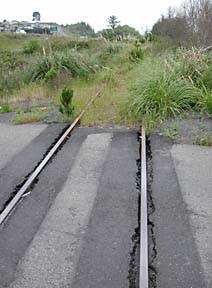 A rock and a hard
place A rock and a hard
place
State politicians and bureaucrats
-- to say nothing of local elected officials -- would probably
find all of this an extremely unappetizing prospect. They may
yet be forced to face it. What's the alternative? If the state
were to deny additional funds to the NCRA -- or, further down
the road, if any state agency were to take the side of environmentalists
and therefore queer the deal with the railroad's potential investor
-- it would mean bankruptcy for the NCRA. One NCRA study estimated
that decommissioning the railroad, which, due to environmental
regulations, would require the removal of the entire track as
well as bridges and tunnels, would cost upwards of $170 million
dollars. And since the Eel River Canyon, the most troubled section
of line, cannot be reached by road, the only way in is by rail
(doing the decommissioning job by helicopter is impractical).
Which means that track would have to be fixed before it could
be removed. The Southern Pacific had planned to do all this work
when it proposed to retire the line in the 1980s. Now, it's the
state's problem.
And to be sure, it would be
California's responsibility. "If there are no assets, no
resources, the line becomes the state's problem," Hauser
said. "When we set up the NCRA, we kept it separate from
the counties. We made sure, because of the potential liabilities,
that the state couldn't say, `Counties, you take over.'"
Call it the NCRA's ultimate
bargaining chip in dealing with the state. At a January meeting
of the NCRA's board of directors, Director Hemphill quoted Hauser
-- who, after leaving the Legislature, served for a time as the
NCRA's executive director -- colorfully suggesting what the NCRA
should do should the state not cough up the money for the beleaguered
railroad.
"Throw the keys at them,"
Hauser reportedly said.
This ace in the hole means that
whether or not the state has doubts about the NWP's potential
economic stimulus, the viability of the NCRA's new geotechnical
plan or the wisdom of introducing a major industrial plant into
an environmentally sensitive watershed, it may find few options
but to let the authority forge ahead. It can pay now -- or it
can pay more later. Whichever course it chooses, its lawyers
had better prepare for a long, expensive ride.
See Northwestern Pacific System map
Hank Sims is freelance writer
living in Westhaven. An earlier version of this article, by the
same author, appeared in the March 2003
issue of the California Journal, a Sacramento-based
publication that covers state politics.
IN
THE NEWS | GARDEN | PUBLISHER | CALENDAR
Comments?

© Copyright 2003, North Coast Journal,
Inc.
|